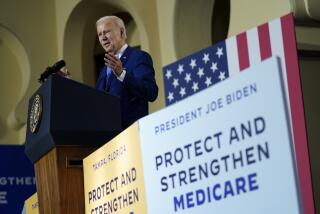Medicare Study Finds Reforms’ Impact Mixed : Improved In-Hospital Mortality Rate Offset by Hike in Release and Deaths of Unstable Patients
- Share via
WASHINGTON — The quality of hospital care under the federal Medicare program appears to have improved in recent years, but many of the gains may be lost because more of the nation’s elderly are being discharged with unstable conditions, according to an extensive new study by researchers at the Santa Monica-based RAND Corp. and UCLA Medical Center.
Between 1981-82 and 1985-86, in-hospital mortality declined, and measures of the quality of physician and nursing care “are better, but more patients are discharged unstable,” Dr. Katherine L. Kahn, the researcher who led the study, said Saturday at the annual meeting of the American Federation for Clinical Research. “By 30 days after admission, most gains in in-hospital mortality have disappeared.”
The death rates after leaving the hospital were “significantly higher” for patients discharged with uncorrected problems such as chest pain, confusion and rapid heart beat than for patients sent home with no “instabilities,” Kahn said. This finding was true even after the researchers excluded terminally ill patients and adjusted for variations in the sickness of patients at admission to the hospital.
The RAND study comes six years after Congress enacted far-reaching Medicare reforms that provided substantial financial incentives for shorter hospital stays and more efficient care. The study is one of the most comprehensive examinations to date of the effects of federal cost-saving measures and the watchdog groups known as peer review organizations on the quality of care provided by Medicare, the federal health insurance program for the elderly and disabled. In 1987, there were about 33 million Medicare beneficiaries.
In another key finding, the RAND researchers found that elderly patients admitted to the hospital in 1985-86 tended to be sicker than those admitted in 1981-82.
But between the two time-periods, in-hospital mortality for a sample of 14,167 elderly patients with one of five life-threatening conditions fell from 16.1% to 12.8%, according to the study. This decrease was particularly striking, because the death rates had been adjusted for variations in the sickness of patients at admission to the hospital.
Yet, as of 30 days after hospital admission, the overall death rates, when similarly adjusted, were essentially the same--16.7% in 1981-82 and 15.7% in 1985-1986.
Concerns about the quality of hospital care under the Medicare program stem largely from the radical shift Congress made in 1983, in the way the government treats hospitals. Previously, hospitals under a “fee-for-service system” had made their own decisions on treatment of elderly patients, established their own charges, and then billed Medicare.
Pays Fixed Sum
Since 1983, Medicare has paid hospitals a fixed sum, set in advance, for each patient who is admitted. The goals of this “prospective payment system” are to encourage efficient medical care, while discouraging prolonged hospital stays and excessive tests and treatments.
Medicare’s standardized payments are calculated separately for about 500 categories of ailments, called diagnosis-related groups or DRGs. Both the DRGs and the payments are periodically adjusted to reflect changes in medical practice and the cost of care.
In 1984, the Health Care Financing Administration (HCFA), which is responsible for Medicare, also established a network of peer-review organizations to monitor hospital use and the quality of care under the program. These organizations have far-reaching powers. For instance, they can block federal reimbursement for admissions that are judged to be either unnecessary or too long and discipline doctors and hospitals for substandard care.
The new RAND study, which was funded in large part by HCFA, appears to send a mixed message about the impact of the Medicare reforms, although Kahn cautioned that the analysis of the data was continuing and that more complete reports would be forthcoming.
Calls News Encouraging
“We feel most of it is pretty encouraging news,” said C. Ross Anthony, a senior HCFA official. “The overall reading of the study is that the prospective payment system seems to be working well and has not resulted in lower quality of care.”
But Anthony, HCFA’s associate administrator for program development, added that Medicare would need to “look more carefully” at “troublesome” areas, such as the apparent increase in mortality for patients after they leave the hospital.
Kahn also cautioned that the impact of the Medicare reforms may have changed since the 1985-86 data was collected. “Since then, the payment screws have been tightened and (the situation) could be different now,” she said.
Health care experts consider the new RAND study particularly significant because it involved a detailed review of large numbers of individual case histories by specially trained nurses and physicians. More than 90% of the medical records and related Social Security files were available for review.
By comparison, most previous studies of patient care under the prospective payment system have relied on anecdotal reports, aggregate statistical data, or smaller and less sophisticated reviews of medical records.
The RAND researchers studied 16,762 Medicare in-patients, age 65 years or older; two-fifths were at least 80 years of age. About 14,000 of the patients had one of four serious medical problems that are common causes of in-hospital death in the elderly--congestive heart failure, heart attack, pneumonia, stroke--or one common surgical condition, hip fracture. Additional data on patients with depression was not presented.
To achieve what the researchers said was a “nationally representative” sample, patients from 297 hospitals in 22 towns or cities in five states were studied. The hospitals and states were not identified. Half of the patients were hospitalized before the new payment system was adopted, the other half when the new system was in effect.
After collecting extensive data using hundreds of specific criteria, the researchers examined death rates for the five conditions. They also studied related measures of the severity of illness of patients, complications and the quality of medical and nursing care.
Among other results, Kahn, Dr. Robert H. Brook and a team of nine other researchers found:
--On average, patients who were judged to have had “better” physician and nursing care had “significantly lower mortality” than other patients. This relationship between the “process” and “outcome” of medical care is considered self-evident by many, but it has been very difficult to demonstrate in rigorous medical studies. The relationship was found for heart failure, heart attack, pneumonia and stroke patients but not for hip fracture patients.
--For the five conditions and for all measures of the process of hospital care except the use of intensive care units, process “was significantly better” under the prospective payment system. The improvement may not necessarily have been caused by the implementation of the prospective payment system; rather it may have resulted from other simultaneous changes that were occuring in medical care.
--Congestive heart failure patients discharged with three or more unstable conditions had a 17% death rate within 30 days of hospital admission, compared to 5% for such patients discharged with no instabilities. Under the prospective payment system, an additional 8.1% of patients were discharged with at least one instability, compared to the old payment system.
--Under prospective payment, heart attack, pneumonia and hip fracture patients were significantly sicker at admission. The length of hospital stay for the five conditions decreased 23%, which was an “even steeper rate” than it had been decreasing previously. The drop in length of stay ranged from 1.7 days for pneumonia to 5.6 days for hip fracture.
In 1987, total reimbursement under the Medicare program was $69.4 billion, including $38 billion for short-stay hospitalizations, according to federal statistics.
Robert Steinbrook reported from Los Angeles and Ronald J. Ostrow reported from Washington.






